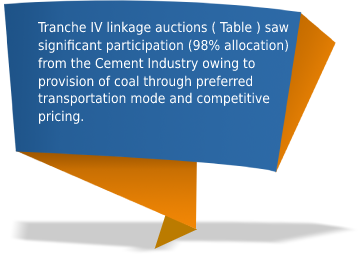Domestic Indian coal, owing to natural quality limitations and supply constraints, makes up for only a small share of the total energy need of the Cement Sector. Coal India Limited (CIL) and Singareni Collieries Company Limited (SCCL) are the prime suppliers of domestic coal. While almost 65% of the total domestic coal is sourced from CIL, the remaining 35% is procured from SCCL. Allocating a priority status to the Cement Industry for supplies of high grade domestic coal would ensure that the most efficient Cement Industry receives the best quality of coal bringing in its fold multiplier benefits associated with increasing the life of mineral bearing mines and conserving other natural resources.
The Indian Cement Industry is Aatmanirbhar and can the present and future demands of a rapidly developing Nation. Maximising the input energy needs from domestic sources would be the next step towards making the entire cement value chain Aatmanirbhar. Following actionable areas could maximise Cement Industry’s energy requirements from domestic sources:
A majority of the current coal production by CIL falls in the G9-G14 grades (~75%) owing to the natural limitation of the available mineral. Table details the production share of high grade coal by various CIL subsidiaries. Coal subsidiaries like Northern Coalfields Limited (NCL) and Eastern Coalfield Limited (ECL), accounting for about 65% of high grade coal production, have significant potential to meet the needs of energy intensive sectors like Cement. In the most recently concluded tranche V linkage auctions conducted by CIL, 31.8% of the high grade coal was offered from (ECL) and 61.7% from SECL.
| CIL Subsidiary | % share in country’s high grade non coking coal production |
|---|---|
| NCL | 39% |
| ECL | 26% |
| SECL | 21% |
| Bharat Coking Coal Limited (BCCL) | 6% |
| CCL | 5% |
| WCL | 3% |
| NECL | 0.3% |
| Mahanadi Coalfields Limited (MCL) | 0.2% |
The tranche linkage auctions are the preferred mode of domestic coal procurement for the Cement Industry as it can contribute to some semblance of supply and price certainty. Table depicts high grade coal offered by various subsidiaries of Coal India Limited in the five Tranche Linkage Auctions conducted till date. South Eastern Coalfields Limited (SECL) has been consistently offering the highest quantum of high grade coal in all the tranche auctions to the Cement Industry
| Coal Subsidiary | Tranche I | Tranche II | Tranche III | Tranche IV | Tranche V |
|---|---|---|---|---|---|
| High Grade Coal (G1- G8) in tonnes | 11,30,000 | 14,70,000 | 3,00,000 | 18,70,000 | 10,96,000 |
| South Eastern Coalfields Limited (SECL) | 53.8% | 89.8% | 100% | 85.6% | 61.7% |
| Northern Coalfields Limited (NCL) | 21.5% | 10.2% | - | - | |
| Western Coalfields Limited (WCL) | 14.0% | - | - | - | |
| North Eastern Coalfields Limited (NECL) | 10.8% | - | - | - | |
| Central Coalfields Limited (CCL) | - | - | 10.7% | 6.6% | |
| Eastern Coalfields Limited (ECL) | - | - | 3.7% | 31.8% |
In India, the Cement Industry is primarily concentrated in the western and southern India while the coal production centres are located in eastern India. Provisioning of coal supply through the railways provides for economical transportation and is a greener alternative to road transportation. Tranche IV linkage auctions ( Table ) saw significant participation (98% allocation) from the Cement Industry owing to provision of coal through preferred transportation mode and competitive pricing. Even the lower grades of coal (G9-G12), utilised in Captive Power Plant (CPP), offered in the tranche IV linkage auctions saw over 80% allocation to the Cement Industry owing to a winning combination of mode of transport and competitive pricing.
| Tranche IV Auction | Offered G1-G8 Grade Coal | Coal Offered Railway Mode | Coal Offered Road Mode | Allocated G1-G8 Grade Coal |
|---|---|---|---|---|
| High Grade Coal | 1.87 | 0.75 | 1.12 | 1.84 |
| SECL | 1.60 | 0.50 | 1.10 | 1.59 |
| CCL | 0.20 | 0.20 | - | 0.20 |
| ECL | 0.07 | 0.05 | 0.02 | 0.05 |
Higher ash content in domestic coal necessitates coal washing at the source to facilitate transportation to distant plants across the Country. It would otherwise be economically unviable for the coal consumer industries as it ends up effectively paying a substantive amount for moving embedded ash content over a long distance. Adoption of best practices such as the American Society for Testing and Materials (ASTM) standards, digital technologies such as Gamma Ray Analyser and On Belt Analyser, partnering with credible third parties and National Accreditation Board for Testing and Calibration Laboratories (NABL) accredited labs would enable effective quality control and assurance of supplies coal which could help foster consumer confidence in the domestic coal.
A Cement plant requires a consistent supply of both Cement kiln grade(G1-G8) coal and CPP grade coal (G9-G12) for manufacturing cement. In a scenario, wherein the materialisation of coal rakes is not balanced, the current policies do not allow for coal procured in an auction process for a cement kiln to be diverted to the CPP and vice versa within the same plant. Additionally, the utilisation of coal supplies from one cement plant toanother of the same Company is also not permitted even if the two plants are in close proximity to each other. Flexibility in the end use of allocated coal would help foster Ease of Doing Business (EoDB) along with enabling optimal utilisation of coal yards.
India is endowed with the fifth largest reserves of global coal. Flexible end use policies, competitive price, stringent quality norms and reliable supplies of high grade coal to amongst the most energy efficient Industries like Cement could be a game changer in the upcoming tranche auctions and would lead to aatmanirbharta in energy supplies.
